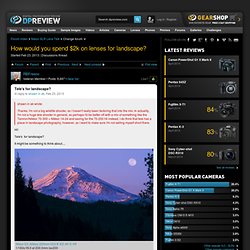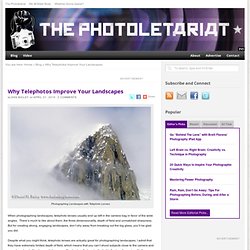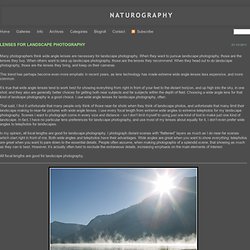

Choosing a Telephoto Zoom Lens « Nick Carver Photography – Fine Art Landscape Photography, Online Photography Courses, Private Photography Lessons and Photography Classes. 14May/12 Along with a good mid-range zoom lens and a wide-angle zoom, a telephoto zoom will round out your collection of lenses quite nicely.

A telephoto lens will zoom in further and magnify the subject more than a typical mid-range kit lens. This makes them great for "reaching" those far away subjects like wildlife, sports and even detail shots on landscapes. This is 200mm on a full-frame camera (equiv. to 125mm on a small-frame) Tele's for landscape?: Nikon SLR Lens Talk Forum. Shawn in ak wrote:Thanks.

I'm not a big wildlife shooter, so I haven't really been factoring that into the mix. In actuality, I'm not a huge tele shooter in general, so perhaps I'd be better off with a mix of something like the Tamron/Nikkor 70-300 + Nikkor 14-24 and saving for the 70-200 f/4 instead. I do think that tele has a place in landscape photography, however, so I want to make sure I'm not selling myself short there. Hi! Tele's for landscape? It might be something to think about.... No EXIF data. Nikon D3 ,Nikkor 200mm f/2G IF-ED AF-S VR 1/160s f/9.0 at 200.0mm iso200. Why Telephotos Improve Your Landscapes. Photographing Landscapes with Telephoto Lenses When photographing landscapes, telephoto lenses usually end up left in the camera bag in favor of the wide angles.

There’s much to like about them; the three-dimensionality, depth of field and unmatched sharpness. But for creating strong, engaging landscapes, don’t shy away from breaking out the big glass, you’ll be glad you did. Despite what you might think, telephoto lenses are actually great for photographing landscapes. I admit that they have extremely limited depth of field, which means that you can’t shoot subjects close to the camera and expect any level of background sharpness.
I can live with those limitations; long lenses give you two things that you can’t get with other lenses: power and isolation. By using a telephoto lens to photograph landscapes, you can create strong images that show only an abbreviated portion of the scene. Pro Secrets: how to use a telephoto lens for awesome landscapes. When you’re shooting landscape photography, the temptation is to reach for a wide-angle lens and try to include everything that your eye can see.

There’s nothing wrong with this approach, but for a more intimate view of the scenery you can add impact to your images by learning how to use a telephoto lens to pick out key features within the bigger picture. Images by Mark Hamblin By emphasising the most visually striking elements, you can add real impact to pictures and make them much stronger in terms of composition. When you use a telephoto lens for your landscapes, it’s a case of less is more. Keep it simple, cut the superfluous aspects and concentrate on what matters.
There are no hard and fast rules for when to shoot long rather than wide, and you’ll often do both during a shoot. The thing to look for is a strong feature that will form the focal point or primary visual impact of the picture. So what equipment do you need? Lenses For Landscape Photography » Naturography – Nature Photography By Mike Spinak. Many photographers think wide angle lenses are necessary for landscape photography.

When they want to pursue landscape photography, those are the lenses they buy. When others want to take up landscape photography, those are the lenses they recommend. When they head out to do landscape photography, those are the lenses they bring, and keep on their cameras. This trend has perhaps become even more emphatic in recent years, as lens technology has made extreme wide angle lenses less expensive, and more common. It’s true that wide angle lenses tend to work best for showing everything from right in front of your feet to the distant horizon, and up high into the sky, in one shot; and they also are generally better choices for getting both near subjects and far subjects within the depth of field. Landscape photography: How to shoot great landscape pictures. When framing landscape pictures, rules will get you only so far.

Niall Benvie describes how thoughtful composition can improve the power of your landscape photography. Landscape photography: Think about the foreground ‘The big foreground’ is a favourite compositional device among landscape photographers. With a wideangle lens fitted, the photographer moves in close to a foreground element, giving it prominence and exaggerating perspective. If the lens is (35 mm-equivalent) 20mm or wider, the effect is almost always impressive. Many of these landscape shots fail because all the foreground has to offer is an insignificant pebble or dead stick while a fascinating mountain range or sky in the distance is diminished. Here, I got in really close to the life belt, being careful to make a secondary framing of the rugged island of Tindholmur through it. Route 10 near Skalafjordur, Eysturoy, the Faroe Islands.1/25sec @ f/7.1, ISO 100. Lenses For Landscape Photography » Naturography – Nature Photography By Mike Spinak.
Pyrenees Photo.